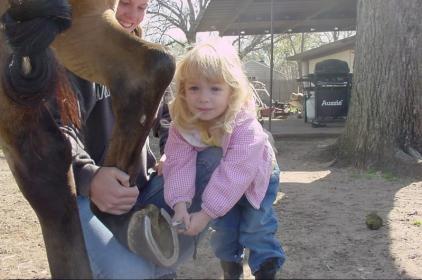You’re the barn manager, right? So set the expected level of care first with the instructor, who should then pass along to students. If instructor is unwilling to enforce the barn’s expected level of care, they should not be an instructor at that facility.
1. How do I fix this? If I tell parents that their kids aren’t ready to be left alone, it will result in less riding time in the lesson and the parents will be annoyed and adults will be insulted.
Riding lessons should be more about than just riding. Either be a barn with grooms who do everything so the princes and princesses get a full hour of ride time, or be a barn who requires learning all aspects of horse care. If a student (adult or minor) can’t tack up correctly on their own, they tack up during their lesson time with the help of the instructor until they can do it correctly on their own. Period. Not negotiable. If adults are “insulted,” I’d kindly invite them to abide by the rules or not return. Rules are rules, and these animals deserve to be treated well for all they do for us.
Or, of course, they can pay for two lessons so they have ample time. Reserve the instructor from 4-6p, so the instructor can help them tack up/un tack, and they still get an hour of riding time. Point is, time paid for is time received. No exceptions. It blows my mind when people read lesson prices of say, $60/hour, but expect to get 20 minutes before and after of free time and assistance from the instructor.
2. How do you supervise people who are left on their own? ( I realize that “supervise” and “left on their own” is an oxymoron)
As others mentioned, an experienced helper kid who can hang around and watch/help in exchange for ride time is a great solution. I did this as a teen. My lessons were on Saturdays at 11a, I stayed until ~6p helping my instructor with tacking up less experienced students, setting jumps, etc. and got more ride time for it.
3. If you let people groom and tack on their own, do they have to pass a test first?
Absolutely.
4. Are your instructors expected to “pre groom” horses so they aren’t quite so dirty for the students? The mud this winter is killing us.
What? No. I have never heard of this. Students can plan to arrive earlier if they need more grooming time, or it can cut into their riding time. Their decision. If you really don’t want to enforce this, perhaps get a sheet for all of them to wear when they go out so they don’t get soo muddy.
5. How long before the first lesson are your instructors expected to be there? (all lesson horses are in)
Depends on if they assist with other barn chores, first lesson needs help tacking up, etc. I’ve never heard of requiring an instructor to be present a specific amount of time before the first lesson of the day “just because.”
Something that can help with students that are new to tacking up on their own, and though capable may still be a bit forgetful, is to have a list of instructions written up. Either a general list for all horses, or an individual list for each horse. A general list could be provided on a chalk board or dry erase board in the aisle/grooming area.
Ex.
- Check board for horse assignment
- Retrieve all grooming supplies and tack for horse
- Retrieve horse from stall or field and put in grooming area
- Remove mud with curry comb
- Brush off all loose dirt with hard brush
- Brush face with soft brush
- Pick hooves
- Put on saddle pads, saddle, then girth
etc. etc. etc.

